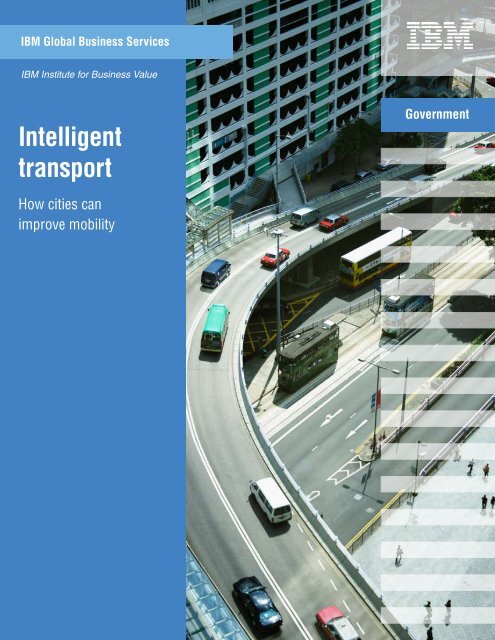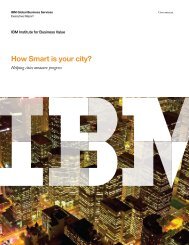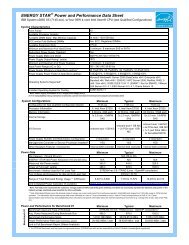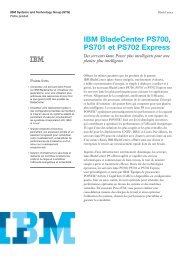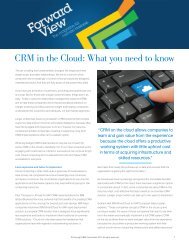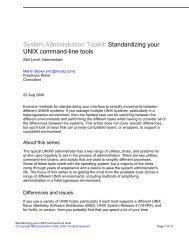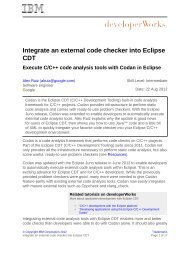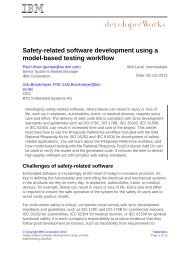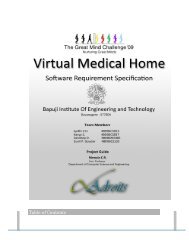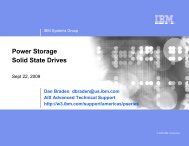Intelligent transport: How cities can improve mobility
Intelligent transport: How cities can improve mobility
Intelligent transport: How cities can improve mobility
You also want an ePaper? Increase the reach of your titles
YUMPU automatically turns print PDFs into web optimized ePapers that Google loves.
IBM Global Business Services<br />
IBM Institute for Business Value<br />
<strong>Intelligent</strong><br />
<strong>transport</strong><br />
<strong>How</strong> <strong>cities</strong> <strong>can</strong><br />
<strong>improve</strong> <strong>mobility</strong><br />
Government
IBM Institute for Business Value<br />
IBM Global Business Services, through the IBM Institute for Business Value,<br />
develops fact-based strategic insights for senior business executives around critical<br />
industry-specific and cross-industry issues. This executive brief is based on an<br />
in-depth study by the Institute’s research team. It is part of an ongoing commitment<br />
by IBM Global Business Services to provide analysis and viewpoints that help<br />
companies realize business value. You may contact the authors or send an e-mail to<br />
iibv@us.ibm.com for more information.
<strong>Intelligent</strong> <strong>transport</strong><br />
<strong>How</strong> <strong>cities</strong> <strong>can</strong> <strong>improve</strong> <strong>mobility</strong><br />
By Jamie Houghton, John Reiners and Colin Lim<br />
1<br />
Cities face urgent <strong>transport</strong> challenges. Many are starting to tackle<br />
them by implementing new intelligent <strong>transport</strong> systems, and some<br />
have achieved impressive benefits. <strong>How</strong>ever, many <strong>cities</strong> are at the<br />
“early adopter” stage. <strong>How</strong> <strong>can</strong> they move forward? We believe five<br />
recommendations <strong>can</strong> assist <strong>cities</strong> in using new technologies to achieve<br />
optimized, integrated <strong>transport</strong> services.<br />
The world is urbanizing rapidly, and population<br />
densities are increasing. A United Nations<br />
report estimates approximately 70 percent<br />
of the world’s population will live in <strong>cities</strong> by<br />
2050. 1 This growth is expanding demands<br />
on urban infrastructures of all kinds, including<br />
<strong>transport</strong>.<br />
IBM research in over 50 developed and developing<br />
world <strong>cities</strong> reveals that although <strong>cities</strong><br />
face unique <strong>transport</strong>ation challenges, their<br />
leaders share a number of common ambitions.<br />
2 Most strive for cleaner, less congested<br />
<strong>cities</strong> and <strong>improve</strong>d traffic flow, primarily<br />
through increased use of enhanced public<br />
mass transit systems and other alternatives to<br />
private vehicles. In terms of <strong>transport</strong> systems,<br />
most leaders agree that infrastructure invest-<br />
<strong>Intelligent</strong> <strong>transport</strong><br />
ments are necessary. <strong>How</strong>ever, the constraints<br />
of tight capital budgets are driving an<br />
increased focus on the need to better manage<br />
<strong>transport</strong> demand and supply through<br />
deploying intelligent <strong>transport</strong> systems (ITS).<br />
The majority of <strong>cities</strong> are at an early stage in<br />
understanding and realizing the full potential<br />
of ITS. Our research identifies signifi<strong>can</strong>t gaps<br />
between the progress of the typical city and<br />
the global leading practice. To understand<br />
what the leaders are doing, we talked in depth<br />
to <strong>transport</strong> officials and experts responsible<br />
for <strong>transport</strong> policies, programs and service<br />
operations in selected <strong>cities</strong> about their <strong>transport</strong><br />
visions out to 2020 and the role of ITS<br />
in meeting their objectives. 3 Specifically, we<br />
discussed their strategies and plans for implementing<br />
ITS, their progress and any practical
issues faced during implementation. After<br />
collating their experiences, we summarized a<br />
series of recommendations to assist <strong>cities</strong> as<br />
they progress toward solving <strong>transport</strong> challenges:<br />
• Develop and implement comprehensive ITS<br />
strategies that are long term, flexible and<br />
integrated with the city’s <strong>transport</strong> vision.<br />
• Adopt customer-centered approaches to<br />
<strong>improve</strong> services, understand customers<br />
and influence customer behavior patterns.<br />
• Integrate service delivery across <strong>transport</strong><br />
modes.<br />
• Secure funding and apply innovative<br />
business models.<br />
• Effectively manage implementation by<br />
addressing the complexity of ITS projects.<br />
2 IBM Global Business Services<br />
2 IBM Global Business Services<br />
Some <strong>cities</strong> have already made signifi<strong>can</strong>t<br />
strides in these areas through implementing<br />
ITS (for example, multimodal fare card ticketing).<br />
As technologies mature and <strong>cities</strong><br />
become more experienced in optimizing their<br />
value, we believe more and more <strong>cities</strong> will<br />
adopt global leading practices. In addition,<br />
virtually all <strong>cities</strong> <strong>can</strong> learn from others’ experiences<br />
and accelerate their own programs.<br />
Ultimately, success will be determined by the<br />
leadership qualities of those with responsibility<br />
for developing and executing their city-wide<br />
<strong>transport</strong> strategies.
<strong>Intelligent</strong> <strong>transport</strong><br />
<strong>How</strong> <strong>cities</strong> <strong>can</strong> <strong>improve</strong> <strong>mobility</strong><br />
As part of their<br />
<strong>transport</strong> strategies,<br />
many <strong>cities</strong> have<br />
deployed ITS, and<br />
many others have<br />
plans to do so.<br />
The smart city<br />
The twenty-first century has been described<br />
as “the century of the city” due to increased<br />
urban populations and the expectation that<br />
this trend will continue. 4 Urban growth is<br />
driven by the developing world, and there are<br />
increasing numbers of mega<strong>cities</strong> – those<br />
with ten million or more people. 5 Along with<br />
population growth, there is an increase in car<br />
ownership and demand for <strong>transport</strong> journeys<br />
across all regions (see Figures 1 and 2).<br />
In the developed world, <strong>cities</strong> are increasingly<br />
becoming driving forces of their national<br />
economies (e.g., Tokyo, Paris, Zurich, Prague<br />
and Oslo all produce about a third of their<br />
countries’ gross domestic products, or GDPs). 6<br />
As <strong>cities</strong> grow in economic importance in the<br />
global economy, they often compete to attract<br />
commerce and employment opportunities. The<br />
effectiveness of a city’s <strong>transport</strong> system has a<br />
FIGURE 1.<br />
Personal <strong>transport</strong> activity by region.<br />
Passenger Km (trillions)<br />
80<br />
70<br />
60<br />
50<br />
40<br />
30<br />
20<br />
10<br />
3 <strong>Intelligent</strong> <strong>transport</strong><br />
0<br />
signifi<strong>can</strong>t impact on a city’s attractiveness to<br />
both prospective investors and employees.<br />
The growth of the city presents city leaders<br />
with signifi<strong>can</strong>t challenges and opportunities.<br />
A common emerging theme is the potential<br />
for <strong>cities</strong> to become “smarter” – to apply<br />
advanced technologies to collect more and<br />
better data, analyze it more intelligently and<br />
connect it through more effective networks.<br />
The end result is more efficient, effective and<br />
targeted services for citizens.<br />
Cities are starting to use smarter solutions<br />
in the areas of water, wastewater, electricity<br />
supply and public safety. <strong>How</strong>ever, the adoption<br />
of smart solutions is perhaps most<br />
advanced in the area of <strong>transport</strong>, with many<br />
<strong>cities</strong> having deployed intelligent <strong>transport</strong><br />
systems and many others planning them as<br />
part of their <strong>transport</strong> strategies.<br />
Africa<br />
Latin America<br />
Middle East<br />
India<br />
Other Asia<br />
China<br />
Eastern Europe<br />
Former Soviet Union<br />
OECD Pacific<br />
OECD Europe<br />
OECD North America<br />
2000 2010 2020 2030 2040 2050<br />
Note: OECD = Organisation for Economic Co-operation and Development.<br />
Source: “Mobility 2030: Meeting the challenges to sustainability.” The Sustainable Mobility Project. World Business Council for Sustainable<br />
Development. December 2004.
FIGURE 2.<br />
Personal <strong>transport</strong> activity by mode.<br />
80<br />
Passenger Km (trillions)<br />
70<br />
60<br />
50<br />
40<br />
30<br />
20<br />
10<br />
0<br />
2000 2010 2020 2030 2040 2050<br />
Today’s <strong>transport</strong> challenges<br />
Transport is perhaps one of the most urgent<br />
issues facing most <strong>cities</strong> today. A 2006 study,<br />
“Megacity Challenges, A stakeholder perspective,”<br />
found that <strong>transport</strong> was the single<br />
biggest infrastructure challenge for <strong>cities</strong> at all<br />
stages of development. 7 Effective <strong>transport</strong> is<br />
central to a city’s economic competitiveness,<br />
and severe congestion is known to have an<br />
equally severe economic cost, estimated as<br />
high as between 1 and 3 percent of GDP in<br />
developed and developing countries. 8 Equally<br />
important, <strong>transport</strong> is an experience shared<br />
by almost all of a city’s inhabitants and directly<br />
affects their well being. Transport is also<br />
responsible for a large share of emissions,<br />
which authorities increasingly want to control.<br />
Our research reveals a common set of <strong>transport</strong><br />
challenges. The most severe challenges<br />
reported include increasing congestion<br />
on all modes of <strong>transport</strong>, customer safety,<br />
a decaying <strong>transport</strong> infrastructure, under<br />
funding, growing negative environmental<br />
4 IBM Global Business Services<br />
Minibuses<br />
Buses<br />
Passenger rail<br />
Two- and three-wheelers<br />
impacts and the pressure to <strong>improve</strong> a city’s<br />
economic competitiveness.<br />
While there are similarities, the exact nature<br />
of the challenges and planned solutions vary<br />
for each individual city based on a number of<br />
factors, including the city’s stage of development,<br />
physical characteristics, existing levels of<br />
<strong>transport</strong> infrastructure and citizen preferences<br />
(see Figure 3). For example, Amsterdam and<br />
Chicago are both mature <strong>cities</strong> but have very<br />
different characteristics that will shape their<br />
<strong>transport</strong> ambitions: in Amsterdam, over 50<br />
percent of daily trips are on foot or on bicycle,<br />
whereas in Chicago, just under 90 percent are<br />
by private car. 9<br />
“Total <strong>mobility</strong> is the most<br />
compelling driver. The emphasis<br />
must be on achieving traffic<br />
outcomes that benefit the city and<br />
its people – be they permanent or<br />
visiting.”<br />
Phil Mumford, CEO, Queensland Motorways Ltd.<br />
Air<br />
Light duty vehicles<br />
Source: “Mobility 2030: Meeting the challenges to sustainability.” The Sustainable Mobility Project. World Business Council for Sustainable<br />
Development. December 2004.
Effective <strong>transport</strong><br />
is central to a<br />
city’s economic<br />
competitiveness.<br />
FIGURE 3.<br />
Regional <strong>transport</strong> challenges, priorities and solutions.<br />
Emerging Markets<br />
• Increasing urbanization (especially in the mega <strong>cities</strong>)<br />
has resulted in worsening congestion, which has<br />
adverse economic and health impacts. Funding and<br />
safety are major issues.<br />
• Most <strong>cities</strong> are focused on developing their <strong>transport</strong><br />
infrastructure, especially highways, railways and metro<br />
systems, while improving their traffic systems.<br />
• Leading <strong>cities</strong>, including Dubai, Beijing and New Delhi,<br />
are implementing ambitious and innovative programs.<br />
Western Europe<br />
• Most European <strong>cities</strong> already have expansive roads and<br />
public <strong>transport</strong> infrastructure. Europe is also home<br />
to many pioneering leaders, including London and<br />
Stockholm.<br />
• Many <strong>cities</strong>/countries are seriously considering<br />
congestion charging, including the use of nextgeneration<br />
GPS-based solutions, especially for trucks.<br />
• Greater demand for public <strong>transport</strong> interoperability at<br />
the metropolitan, regional and national levels.<br />
Source: IBM Institute for Business Value interviews and analysis of publicly available information.<br />
Virtually all <strong>cities</strong> are developing visions<br />
and strategies to address their particular<br />
challenges and <strong>improve</strong> <strong>mobility</strong>, usually<br />
by changing modal shares and delivering<br />
<strong>improve</strong>d <strong>transport</strong> services. In addition, nearly<br />
all of the city leaders interviewed highlight the<br />
importance of ITS in tackling their <strong>transport</strong><br />
challenges.<br />
“Allowing congestion to grind <strong>cities</strong>, suburbs<br />
and supply chains to a halt every morning<br />
and afternoon is unacceptable when we have<br />
innovative tools, technologies and strategies<br />
available to manage our <strong>transport</strong>ation<br />
systems and utilize our infrastructure more<br />
effectively,” states Scott Belcher, president and<br />
chief executive officer (CEO) of ITS America.<br />
5 <strong>Intelligent</strong> <strong>transport</strong><br />
Asia Pacific (mature)<br />
• The mature Asia-Pacific <strong>cities</strong> include several global<br />
<strong>transport</strong> leaders (e.g., Tokyo, Seoul and Singapore),<br />
which have extensive public <strong>transport</strong> systems.<br />
• Regional innovations include advanced traffic and bus<br />
management systems, integrated fare systems and<br />
traveler information.<br />
• Congestion remains a key concern, with several <strong>cities</strong>/<br />
countries considering various congestion charging<br />
solutions.<br />
North America<br />
• The private car is the key mode of <strong>transport</strong> in most U.S.<br />
<strong>cities</strong>. <strong>How</strong>ever, the high cost of congestion (time and<br />
gallons wasted) is measured in the billions.<br />
• Issues include signifi<strong>can</strong>t funding challenges for new<br />
infrastructure, maintenance of existing infrastructure<br />
and achieving quality service levels. An overhaul of the<br />
gas tax is being considered with higher rates and user<br />
charges being introduced.<br />
• The new administration is encouraging railways and<br />
public <strong>transport</strong> <strong>improve</strong>ments while new approaches in<br />
tolling are being explored.<br />
<strong>Intelligent</strong> <strong>transport</strong> systems<br />
<strong>Intelligent</strong> <strong>transport</strong> systems have been around<br />
for many years, but more recently, global <strong>cities</strong><br />
have been implementing a new generation of<br />
ITS. Some examples include:<br />
•<br />
Integrated fare management<br />
• Enhanced transit/customer relationship<br />
management<br />
•<br />
•<br />
•<br />
•<br />
•<br />
Traffic prediction<br />
Improved <strong>transport</strong> and traffic management<br />
Traveler information and advisory services<br />
Road user charging<br />
Variable parking pricing.
ITS technologies also create the potential for<br />
new information-based services like pre-trip<br />
and on-trip journey planning and traffic alerts,<br />
as well as different pricing and business<br />
models, such as variable pricing based on<br />
usage, emissions or peak times.<br />
As part of its research, IBM has studied a<br />
number of <strong>cities</strong> over several years as they<br />
implement ITS. Our findings suggest that<br />
intelligent <strong>transport</strong> systems are about much<br />
more than discrete software solutions. Leading<br />
<strong>cities</strong> are implementing broader strategies to<br />
help them move from single mode operation<br />
to more sophisticated multimodal <strong>transport</strong><br />
services and integrated <strong>transport</strong> delivery.<br />
Their strategies address three main areas:<br />
governance, <strong>transport</strong> network optimization<br />
and integrated <strong>transport</strong> services. Typically,<br />
FIGURE 4.<br />
IBM <strong>Intelligent</strong> Transport Maturity Model (summary version).<br />
Governance<br />
• Strategic planning<br />
• Performance<br />
management<br />
• Demand<br />
management<br />
Transport network<br />
optimization<br />
• Data collection,<br />
integration and<br />
analysis<br />
• Network<br />
operational<br />
responsiveness<br />
• Incident<br />
management<br />
Integrated <strong>transport</strong><br />
services<br />
• Customer<br />
management<br />
• Payment systems<br />
• Traveler<br />
information<br />
Level 1<br />
Single mode<br />
Single mode<br />
planning with little<br />
coordination between<br />
various <strong>transport</strong><br />
providers.<br />
Limited data<br />
collection and<br />
integration. Ad hoc<br />
analysis and incident<br />
response. Manual<br />
incident response by<br />
individual modes.<br />
Minimal; mostly cash<br />
collection. Limited<br />
and static traveler<br />
information.<br />
Source: IBM Global Business Services analysis.<br />
6 IBM Global Business Services<br />
Level 2<br />
Coordinated<br />
modes<br />
A <strong>transport</strong> vision<br />
is articulated.<br />
Single overarching<br />
regulator but with<br />
limited planning and<br />
management powers.<br />
Data collection<br />
for major routes.<br />
Periodic data<br />
collection and<br />
analysis. Network and<br />
incident response<br />
mostly by individual<br />
modes.<br />
Customer accounts<br />
by mode. Mostly cash<br />
collection. Static trip<br />
planning with limited<br />
realtime alerts.<br />
they progress through different levels of<br />
sophistication in each of these three areas,<br />
which we have documented in the IBM<br />
<strong>Intelligent</strong> Transport Maturity Model (see<br />
Figure 4).<br />
Implementing ITS<br />
As <strong>cities</strong> address these three areas and progress<br />
to more integrated and optimized modes<br />
of <strong>transport</strong>ation, many will face implementation<br />
hurdles. <strong>Intelligent</strong> <strong>transport</strong> systems are<br />
relatively new and, although proven technically,<br />
still present challenges, especially around<br />
matching strategic objectives with assured<br />
delivery. Many <strong>cities</strong> freely admit they have not<br />
yet gained all of the anticipated benefits from<br />
their ITS investments, and some look forward<br />
to further evolution of their intelligent trans-<br />
Level 3<br />
Partially<br />
integrated<br />
Integrated multimodal<br />
<strong>transport</strong> authority.<br />
Coordinated demand<br />
management<br />
measures.<br />
Realtime collection<br />
of multiple data<br />
source with high-level<br />
analysis. Automated<br />
network and incident<br />
response systems.<br />
Electronic payments.<br />
Multichannel trip<br />
planning and<br />
account-based alert<br />
subscription.<br />
Level 4<br />
Multimodal<br />
integration<br />
Integrated corridorbased<br />
multimodal<br />
planning. Dynamic<br />
demand management<br />
schemes.<br />
Realtime multimodal<br />
coverage for most<br />
corridors. Detailed<br />
realtime data<br />
analysis. Automated<br />
pre-planned<br />
multimodal incident<br />
response.<br />
Multimodal<br />
integrated <strong>transport</strong><br />
card. On journey,<br />
multimodal<br />
information services.<br />
Level 5<br />
Multimodal<br />
optimized<br />
Integrated regional<br />
multimodal planning.<br />
Continuous systemwide<br />
performance<br />
measures with dynamic<br />
pricing.<br />
System-wide realtime<br />
multimodal data<br />
collection, integration<br />
and analysis. Dynamic<br />
network optimization<br />
and incident response.<br />
Single customer<br />
<strong>transport</strong> account.<br />
Location-based<br />
multimodal proactive<br />
trip advisory.
Many <strong>cities</strong> admit<br />
they have not yet<br />
gained all of the<br />
anticipated benefits<br />
from their ITS<br />
investments.<br />
port systems. Other <strong>cities</strong> are considering ITS<br />
investments but are discouraged by perceived<br />
public resistance or funding challenges.<br />
The IBM <strong>Intelligent</strong> Transport Maturity Model<br />
<strong>can</strong> be used to assess a city’s progress<br />
compared with the global leading practice. As<br />
part of our research, we used a more detailed<br />
FIGURE 5.<br />
Progress profile for a typical city versus global leading practice.<br />
Governance<br />
Transport<br />
network<br />
optimization<br />
Integrated<br />
<strong>transport</strong><br />
services<br />
Strategic<br />
planning<br />
Performance<br />
measurement<br />
Demand<br />
management<br />
Data<br />
collection<br />
Data<br />
integration<br />
and analytics<br />
Network<br />
operations<br />
response<br />
Incident<br />
management<br />
Customer<br />
relationships<br />
Payment<br />
systems<br />
Traveler<br />
information<br />
Source: IBM Global Business Services analysis.<br />
7 <strong>Intelligent</strong> <strong>transport</strong><br />
Level 1<br />
Single mode<br />
Functional area<br />
planning (singe<br />
mode)<br />
Level 2<br />
Coordinated<br />
modes<br />
Project-based<br />
planning (single<br />
mode)<br />
Minimal Defined metrics by<br />
mode<br />
Individual static<br />
measure<br />
Limited or manual<br />
input<br />
Limited with ad hoc<br />
analysis<br />
Ad hoc, single<br />
mode<br />
Manual detection,<br />
response and<br />
recovery<br />
Minimal capability,<br />
no customer<br />
accounts<br />
Manual cash<br />
collection<br />
Individual<br />
measures, with<br />
long-term variability<br />
Near realtime for<br />
major routes<br />
Networked but<br />
periodic analysis<br />
Centralized single<br />
mode<br />
Manual detection,<br />
coordinated<br />
response, manual<br />
recover<br />
Customer accounts<br />
managed separately<br />
for each system/<br />
mode<br />
Automatic cash<br />
machines<br />
Static information Static trip planning<br />
with limited realtime<br />
alerts<br />
version of the maturity model to assess the<br />
current positions of a number of <strong>cities</strong> and the<br />
current state of global leading practice, which<br />
comprises the outstanding features of many<br />
individual <strong>cities</strong> (see Figure 5). This benchmark<br />
is itself shifting to the right over time, as<br />
technologies <strong>improve</strong> and <strong>cities</strong> get better at<br />
exploiting them.<br />
Level 3<br />
Partially<br />
integrated<br />
Integrated agencywide<br />
planning<br />
(single mode)<br />
Limited<br />
integration across<br />
organizational silos<br />
Coordinated<br />
measures, with<br />
short-term<br />
variability<br />
Realtime for major<br />
routes using<br />
multiple inputs<br />
Common user<br />
interface with highlevel<br />
analysis<br />
Automated, single<br />
mode<br />
Automated<br />
detection,<br />
coordinated<br />
response, manual<br />
recover<br />
Multichannel<br />
account interaction<br />
by mode<br />
Electronic<br />
payments<br />
Multichannel trip<br />
planning and<br />
account-based alert<br />
subscription<br />
Level 4<br />
Multimodal<br />
integration<br />
Integrated corridorbased<br />
multimodal<br />
planning<br />
Shared multimodal<br />
system-wide<br />
metrics<br />
Typical city Global leading practice<br />
Level 5<br />
Multimodal<br />
optimized<br />
Integrated regional<br />
mulitimodal<br />
planning<br />
Continuous<br />
system-wide<br />
performance<br />
measurement<br />
Dynamic pricing Multimodal<br />
dynamic pricing<br />
Realtime coverage<br />
for major corridors,<br />
all signifi<strong>can</strong>t<br />
modes<br />
Two-way system<br />
integration and<br />
analysis in realtime<br />
Automated,<br />
multimodal<br />
Automated preplanned<br />
multimodal<br />
recovery plans<br />
Unified customer<br />
account across<br />
multiple modes<br />
Multimodal<br />
integrated fare card<br />
Location-based, onjourney<br />
multimodal<br />
information<br />
System-wide<br />
realtime data<br />
collection across<br />
all modes<br />
Extended<br />
integration with<br />
multimodal<br />
analysis in realtime<br />
Multimodal<br />
realtime optimized<br />
Dynamic<br />
multimodal<br />
recovery plans<br />
based on realtime<br />
data<br />
Integrated<br />
multimodal<br />
incentives<br />
to optimize<br />
multimodal use<br />
Multimodal,<br />
multichannel (fare<br />
cards, cell phones,<br />
etc.)<br />
Location-based,<br />
multimodal<br />
proactive rerouting
Our analysis led to several conclusions:<br />
• Different <strong>cities</strong> prioritize the model’s initiative<br />
areas in different ways – there is not one<br />
solution that fits all.<br />
• There is a material gap between the typical<br />
city and the global leading practice.<br />
• There are particularly large gaps in data<br />
collection, data integration and analytics,<br />
and customer relationships.<br />
• The typical city is having difficulty making<br />
progress with data integration and analytics,<br />
especially across modes.<br />
• The more sophisticated services, including<br />
demand management, incident management<br />
and traveler information, are relatively<br />
undeveloped even among leading <strong>cities</strong>.<br />
• All <strong>cities</strong> have bold ambitions – regardless<br />
of current stage of development or current<br />
level of <strong>transport</strong> infrastructure – though their<br />
priorities differ.<br />
• Each city will have a different implementation<br />
path based on its unique starting position<br />
and the priorities it sets out in its <strong>transport</strong><br />
strategy.<br />
Cities <strong>can</strong> map their ITS strategies on this<br />
maturity model to measure their current<br />
progress and compare it to global leading<br />
practices. This <strong>can</strong> then be used both to<br />
validate their strategies against the global<br />
benchmarks and to develop an ITS implementation<br />
roadmap.<br />
8 IBM Global Business Services<br />
Enhancing ITS<br />
Regardless of a city’s current state of ITS<br />
maturity, there is typically room for <strong>improve</strong>ment<br />
and continued development. Therefore,<br />
based on our research and detailed discussions<br />
with city officials, we have identified five<br />
key recommendations to help all <strong>cities</strong> as they<br />
implement ITS.<br />
1. Develop and implement comprehensive<br />
ITS strategies<br />
A leading practice demonstrated by several<br />
<strong>cities</strong> is to develop effective ITS strategies that<br />
are long term and integrated with wider strategies<br />
and plans for <strong>transport</strong>, the city and even<br />
the wider economy. Our research found that<br />
many ITS projects are developed independently<br />
and are not part of a wider strategic ITS<br />
or multimodal <strong>transport</strong> plan. This <strong>can</strong> lead to<br />
difficulties later in gaining the potential network<br />
benefits across all modes that ITS <strong>can</strong> offer.<br />
“We shouldn’t lose sight of 2020<br />
when addressing the challenges<br />
of 2010.”<br />
Julie O’Neil, Secretary General, Department of<br />
Transport, Dublin<br />
An ITS strategy should be long term to anticipate<br />
customer demands for new services<br />
across <strong>transport</strong> modes and the growing<br />
capabilities of emerging technologies, such<br />
as next-generation global positioning system<br />
technologies and the rapid deployment of<br />
personal digital assistants (PDAs) for realtime<br />
information. Also, ITS services are expected
ITS strategies<br />
should be long<br />
term and part<br />
of an overall<br />
<strong>transport</strong> plan.<br />
to expand in scope, linking <strong>cities</strong> with other<br />
<strong>cities</strong>, regions and government agencies. They<br />
also may need to work effectively with a large<br />
number of commercial providers, as many<br />
<strong>cities</strong> view ITS as a platform to deliver a range<br />
of services to customers.<br />
To move toward multimodal and integrated<br />
<strong>transport</strong> services that benefit customers, the<br />
city and the wider economy, ITS projects and<br />
plans need to be joined up at various levels to<br />
show how individual projects contribute to the<br />
delivery of a broad ITS strategy (addressing a<br />
broad set of dimensions listed in the maturity<br />
model). The strategies for a city’s different<br />
<strong>transport</strong> modes also should be integrated as<br />
part of a coherent city <strong>transport</strong> strategy and<br />
need to be consistent with strategies in other<br />
areas of municipal government (for example,<br />
land use planning). In addition, they should be<br />
coordinated with strategies in other levels of<br />
government, including national, regional and<br />
district.<br />
Cities with an integrated <strong>transport</strong> authority<br />
will find it easier to develop and implement<br />
a holistic ITS strategy across all <strong>transport</strong><br />
modes. For example, Transport for London,<br />
which has responsibility for all public <strong>transport</strong><br />
modes within the London metropolitan area<br />
and reports to the Mayor of London, developed<br />
a comprehensive and integrated 20-year<br />
strategy for <strong>transport</strong>, which details how<br />
specific initiatives will contribute to achieving<br />
a wide range of city and even national<br />
objectives. 10 Where formal organization dependencies<br />
do not exist, <strong>cities</strong> need to collaborate<br />
effectively with partner organizations. A<br />
number of <strong>cities</strong> in our research mention the<br />
importance of political support and active<br />
sponsorship in establishing and later implementing<br />
coherent ITS plans.<br />
9 <strong>Intelligent</strong> <strong>transport</strong><br />
In response to the need for integrated <strong>transport</strong><br />
initiatives and the uncertainties involved in<br />
long-term planning, national and international<br />
<strong>transport</strong> authorities are increasingly playing a<br />
role in framing <strong>cities</strong>’ <strong>transport</strong> strategies and<br />
promoting technical standards.<br />
“There is a need for a single<br />
<strong>transport</strong> vision and plan for Egypt<br />
and a central governance and<br />
ownership.”<br />
Omar El Bakary, Deputy Minister, Ministry of<br />
Transport, Egypt<br />
The European Union (EU) is progressing<br />
plans to encourage the adoption of ITS across<br />
Europe based on common frameworks and<br />
standards, stating that “it is not acceptable<br />
anymore to see Member States of the EU<br />
implementing new proprietary road charging<br />
systems. Drivers should have only one system<br />
for the whole Europe and not one per Member<br />
State.” 11<br />
Stockholm increases services, decreases<br />
congestion<br />
The Swedish city of Stockholm has implemented<br />
several global leading practices. Stockholm aims<br />
to be the world’s most accessible capital and<br />
views its <strong>transport</strong>ation system as an important<br />
part of reaching this goal. Stockholm is well<br />
known for its congestion tax, which resulted in<br />
a 25 percent reduction in car use and 14 percent<br />
reduction in emissions from road traffic. 12<br />
<strong>How</strong>ever, it is important to note that Stockholm<br />
implemented the tax as part of a holistic <strong>transport</strong><br />
plan that also increased bus services and parkand-ride<br />
facilities. 13 In addition, Stockholm has an<br />
integrated ticketing system that links the major<br />
modes of <strong>transport</strong>. 14
2. Adopt customer-centered approaches<br />
Customer expectations of <strong>transport</strong> services<br />
are increasing, and <strong>transport</strong> authorities <strong>can</strong><br />
use ITS to deliver both new and <strong>improve</strong>d<br />
services. Many <strong>transport</strong> users have ingrained<br />
behavior patterns based on their perceptions<br />
of the convenience, reliability and cost<br />
of alternative <strong>transport</strong> modes. To optimize the<br />
<strong>transport</strong> network and encourage modal shift,<br />
<strong>cities</strong> need to alter customer attitudes about<br />
the cost, value and use of <strong>transport</strong> systems.<br />
“Londoners should not have to<br />
hunt for <strong>transport</strong> information. It<br />
should be everywhere and easily<br />
accessible.”<br />
Kulver Ranger, Director of Transport Policy to the<br />
Mayor of London<br />
For many <strong>cities</strong>, improving the customer<br />
<strong>transport</strong> experience is the primary objective<br />
of ITS projects, whether by increasing overall<br />
customer satisfaction or encouraging greater<br />
use of public <strong>transport</strong> services. According to<br />
Elio Catania, CEO of Milan’s <strong>transport</strong> authority,<br />
“The key issue is to signifi<strong>can</strong>tly <strong>improve</strong><br />
public <strong>transport</strong> – efficiency, cost, punctuality,<br />
high quality infrastructure / rolling stock,<br />
personal safety, accessibility, etc. – to ensure<br />
that public <strong>transport</strong> becomes a superior alternative<br />
to the car.”<br />
One way to <strong>improve</strong> the <strong>transport</strong> experience<br />
is through Web-based journey planning<br />
services, which <strong>can</strong> help customers optimize<br />
their travel across modes, increasing efficiency.<br />
These services <strong>can</strong> be delivered via mobile<br />
phones and other mobile devices such as<br />
PDAs. Location-based services <strong>can</strong> also be<br />
added, such as tourist information. Some <strong>cities</strong><br />
10 IBM Global Business Services<br />
offer increased convenience for customers<br />
through integrated public <strong>transport</strong> smart<br />
cards, which <strong>can</strong> be used not only for <strong>transport</strong>-related<br />
services, but also as electronic<br />
purses for small purchases.<br />
Understanding patterns of customer demand<br />
and use is very useful in developing customercentered<br />
<strong>transport</strong> strategies. Leading<br />
<strong>cities</strong> are using demand and usage data<br />
to segment customer groups so they <strong>can</strong><br />
provide optimized scheduling services as well<br />
as transparent and targeted communication<br />
to specific groups (e.g., text alerts of traffic<br />
problems and advice about alternative routes<br />
to daily commuters). As Peter Martin, general<br />
manager of tolling for Sydney’s Roads and<br />
Traffic Authority, remarks, “The travelling public<br />
in 2020 will be defined as a number of market<br />
segments…We will see offerings to travelers<br />
that give them a better value proposition but<br />
also offer the city a better proposition.”<br />
To fully utilize the breadth of such capabilities,<br />
<strong>transport</strong> officials need to get much closer<br />
to their customers. Increasingly, <strong>transport</strong> will<br />
embrace techniques used in retail, such as<br />
customer relationship management (CRM)<br />
systems to support and enhance customer<br />
relationships and analyze customer data. Data<br />
will be collected on customer journeys, preferences<br />
and purchasing patterns just as retail<br />
does now. According to Phil Mumford, CEO of<br />
Queensland Motorways, “Supermarkets know<br />
exactly when, where, what and why I buy what<br />
I do. We will be like them around every aspect<br />
of a journey.”<br />
Once they better understand their customers’<br />
travel patterns, city officials <strong>can</strong> more effectively<br />
influence behavior patterns through<br />
incentives (such as improving the quality and
ITS solutions <strong>can</strong> be<br />
used to help <strong>improve</strong><br />
the customer’s <strong>transport</strong><br />
experience and integrate<br />
modes of <strong>transport</strong>.<br />
reliability of preferred <strong>transport</strong> modes) and<br />
pricing mechanisms (ticket pricing, higher<br />
city-center parking charges, emissions-based<br />
charging, road user charging, etc.). In most<br />
cases, a combination of service <strong>improve</strong>ments<br />
and price incentives will be needed to change<br />
customer behavior patterns.<br />
“A key priority is changing<br />
behavior – encouraging a shift to<br />
public <strong>transport</strong> usage by adjusting<br />
the mindset of the commuter.”<br />
Lew Yii Der, Group Director, Policy and<br />
Planning, Singapore LTA<br />
London boosts bus popularity 40 percent<br />
London has been very successful in changing<br />
customer tendencies to make more use of buses,<br />
with a patronage increase of 40 percent since<br />
1999, and 4 percent modal shift from private<br />
vehicles. This was achieved through targeted<br />
initiatives, including expanded services, better<br />
scheduling and connectivity, investment in new<br />
buses, a simpler fare structure and payment<br />
solution, regular travel updates and marketing<br />
campaigns. Shifts have been highest in central<br />
London, assisted by congestion charging and bus<br />
priority measures. 15<br />
3. Integrate service delivery<br />
Almost all <strong>cities</strong> report that <strong>transport</strong><br />
service integration across modes is essential.<br />
According to Dr. Ashwin Mahesh of<br />
Bangalore’s Indian Institute of Management,<br />
“Integration of modes is the only way to<br />
address the problems of congestion and<br />
<strong>mobility</strong>.”<br />
11 <strong>Intelligent</strong> <strong>transport</strong><br />
The objective is to allow the consumer to plan<br />
an optimal journey, irrespective of <strong>transport</strong><br />
mode, and to carry out that journey effectively<br />
(e.g., with connections between modes<br />
and without having to buy separate tickets).<br />
Service integration also helps <strong>transport</strong> authorities<br />
deliver a more efficient service. By sharing<br />
information from different sources, they <strong>can</strong><br />
construct a holistic view of <strong>transport</strong> demand<br />
and supply and make decisions to optimize<br />
the <strong>transport</strong> network. <strong>How</strong>ever, the reality<br />
is that most <strong>cities</strong>’ <strong>transport</strong> services are still<br />
delivered by individual modes.<br />
“Within the city, the integration of<br />
all modes, including the bicycle, is<br />
important.”<br />
Rene Meijer, Vice Director, Infrastructure, Traffic<br />
and Transport, Amsterdam<br />
Service integration is difficult and, while<br />
many have made progress, only a few of<br />
the <strong>cities</strong> in our research have achieved it<br />
to their satisfaction. Integration is required at<br />
many different levels, as <strong>transport</strong> services<br />
are typically delivered by many different<br />
organizations operating in different ways on a<br />
wide range of different systems. Joining all of<br />
these to deliver an integrated service to the<br />
consumer and provide integrated information<br />
to the <strong>transport</strong> authority and consumer is a<br />
daunting political, organizational, procedural<br />
and technical challenge.<br />
From an organizational perspective, the<br />
preferred approach is an integrated <strong>transport</strong><br />
authority, which a number of <strong>cities</strong> have established<br />
and others hope to achieve. Regardless<br />
of organizational structure, it is important that<br />
all who work toward planning and delivering
the city’s <strong>transport</strong> are able to work collaboratively<br />
with effective political support and<br />
sponsorship. At a policy level, this involves<br />
coordination between city, regional and<br />
national <strong>transport</strong> authorities and agencies,<br />
as well as other interested parties, such as<br />
city planners and <strong>transport</strong> service providers.<br />
Collaboration among these multiple entities<br />
is essential to develop coherent strategies,<br />
consistent policies and technical standards<br />
(as described under our first recommendation),<br />
as well as to help ensure plans are<br />
executed in a coordinated way.<br />
At the operational level, much work is<br />
required to integrate processes, policies and<br />
procedures. Employees from different organizations<br />
need to collaborate to deliver an<br />
integrated service to consumers. Scheduling,<br />
ticketing and pricing have to be coordinated<br />
across <strong>transport</strong> providers, and this<br />
has further implications on integration of<br />
back-office functions, such as the need for<br />
common transit customer accounts and<br />
clearing-house functions.<br />
Integration challenges also occur at the<br />
technical level in integrating information<br />
using incompatible standards and<br />
connecting multiple systems. This challenge is<br />
compounded by the complexity and volume<br />
of information flows involved. Cities need to<br />
make more progress in this area, and the<br />
need for effective systems integration is likely<br />
to increase as demands for interoperabilty of<br />
<strong>transport</strong> systems rise.<br />
The long-term answer involves implementing<br />
open information technology architectures and<br />
working with standards-setting bodies to adopt<br />
widely used common or open standards in ITS<br />
applications. For example, the Santiago <strong>transport</strong><br />
authority made the decision to use open<br />
12 IBM Global Business Services<br />
architectures on all ITS projects, is promoting<br />
the development of a national architecture and<br />
is encouraging the use of service-oriented<br />
architecture (SOA) and open standards to help<br />
systems integration. 16<br />
“Our greatest technical challenges<br />
involve integrating systems with<br />
those of other provinces and<br />
changing legacy systems according<br />
to the standards.”<br />
Soojin Lee, City Transportation Headquarters,<br />
Seoul<br />
In Singapore, ITS enables <strong>mobility</strong> – and<br />
shopping<br />
A good example of integrated service delivery<br />
is Singapore’s next-generation multimodal<br />
e-payment system dubbed Symphony for<br />
e-Payment. 17 Based on Contactless E-Purse<br />
Application Standard (CEPAS), an open national<br />
<strong>transport</strong> card standard, the system allows multipurpose<br />
stored value (MPSV) cards to be used<br />
for transit (bus, rail, vehicle congestion charging,<br />
etc.), as well as nontransit purposes, such as<br />
micropayments for retail purchases. In addition, it<br />
provides support for multiple (CEPAS compliant)<br />
card issuers, increasing choice and convenience<br />
for the public commuter. 18<br />
4. Secure funding, apply new business<br />
models<br />
Several city officials describe difficulty in<br />
securing funding as a signifi<strong>can</strong>t barrier to<br />
achieving their <strong>transport</strong> visions. Officials<br />
compete for funding both with counterparts<br />
from different modes of <strong>transport</strong>ation and<br />
more traditional infrastructure projects. A<br />
further challenge is gaining public support for<br />
ITS projects, particularly if citizens are asked to<br />
contribute to costs through increased fares.
Ideally, <strong>cities</strong> need<br />
business models that<br />
both exploit new revenue<br />
opportunities and price<br />
<strong>transport</strong> to support their<br />
<strong>transport</strong> objectives.<br />
“New infrastructure projects<br />
get too much attention at public<br />
planning. We need new priorities<br />
to focus on smart solutions.”<br />
Professor Jonas Eliasson, Royal Institute of<br />
Technology, Stockholm<br />
ITS proposals need to be accompanied by<br />
convincing business cases and supported<br />
by evidence that benefits are being delivered.<br />
According to a senior <strong>transport</strong> official of a<br />
large Chinese city, “Funding is the greatest<br />
challenge in implementation, but funds will<br />
follow if ITS projects prove their value following<br />
evaluation.”<br />
Evaluations should measure a range of benefits<br />
beyond financial payback – for example,<br />
<strong>improve</strong>ments in numbers of accidents (and<br />
traffic related deaths), reduced emissions<br />
and the customer benefits derived from an<br />
enhanced traffic network.<br />
Most <strong>cities</strong> expect <strong>transport</strong> investments to<br />
be funded primarily via general taxation since<br />
the public benefits from reduced congestion<br />
and fewer emissions. Some national <strong>transport</strong><br />
authorities (e.g., those in the United States, the<br />
United Kingdom and Singapore) are trying to<br />
encourage ITS adoption by creating national<br />
funds to support regional and local innovative<br />
<strong>transport</strong> initiatives. 19 Some countries also<br />
look to the private sector for funding. Publicprivate<br />
partnerships have been used for some<br />
time in a number of countries, including the<br />
United States, the United Kingdom, Australia<br />
and South Korea, particularly for infrastructure<br />
projects. 20<br />
13 <strong>Intelligent</strong> <strong>transport</strong><br />
<strong>Intelligent</strong> <strong>transport</strong> systems themselves <strong>can</strong><br />
provide new ways of raising funds, for example,<br />
usage-based charging that varies by vehicle<br />
type, volume of usage or time of day. In addition,<br />
traffic information collected via ITS <strong>can</strong><br />
be sold to consumers in the form of traffic<br />
updates or to private corporations for fleet<br />
management.<br />
In addition to raising valuable revenue, the<br />
pricing of <strong>transport</strong> services <strong>can</strong> impact<br />
customer behavior patterns. Cities should<br />
be cautious that price increases and new<br />
charges do not lead to public opposition. It<br />
is notable that both London and Stockholm<br />
promoted their road user charging plans<br />
not only by stating the benefits of reduced<br />
congestion and lower emissions, but also by<br />
emphasizing that fee revenue would be reinvested<br />
in the <strong>transport</strong> network. 21 Ideally, <strong>cities</strong><br />
need an effective overall business model that<br />
exploits new opportunities for revenue and, at<br />
the same time, prices <strong>transport</strong> in a way that<br />
supports the city’s <strong>transport</strong> objectives.<br />
Oregon taxes miles instead of gas<br />
The U.S. state of Oregon is testing a mileage tax,<br />
based on the number of miles a vehicle is driven,<br />
as a replacement for the state gas tax. Responding<br />
to declining gas tax revenues due to greater fuel<br />
efficiency in cars, the state sees this as a more<br />
equitable way to fund road <strong>improve</strong>ments. 22
5. Effectively manage implementation<br />
While almost all <strong>cities</strong> see the use of intelligent<br />
<strong>transport</strong> systems as central to the delivery of<br />
their <strong>transport</strong> visions, many express concerns<br />
about their capability to implement them.<br />
There are difficulties involved in implementing<br />
large and complex intelligent <strong>transport</strong> projects,<br />
as well as a natural concern that failure<br />
would be highly visible to the public.<br />
With some ITS projects, the implementation<br />
spans different <strong>transport</strong> modes, which often<br />
are the responsibility of different organizations,<br />
resulting in increased complexity. In these<br />
cases, setting up effective governance structures<br />
and sponsorships are important.<br />
Other implementation concerns include the<br />
need for effective change management and<br />
anticipation of potential resistance from staff<br />
and consumers. For example, some <strong>cities</strong> in<br />
our research highlight the need to respond to<br />
consumers’ resistance to privacy-threatening<br />
technologies, such as vehicle plate recognition.<br />
Much <strong>can</strong> be learned from those who have<br />
succeeded in implementing complex information<br />
systems, whether in <strong>transport</strong>ation or other<br />
industries. Several <strong>cities</strong> emphasize the importance<br />
of effective project teams with the right<br />
balance of technical and project management<br />
skills. For example, Akio Shiibashi, the deputy<br />
director of IT-Suica business development in<br />
Tokyo, reports that the technology behind the<br />
integrated Suica rail smartcard was relatively<br />
straightforward. “The key to the successful<br />
implementation was the commitment of the<br />
project team to make it happen,” he says.<br />
14 IBM Global Business Services<br />
Other industries, such as healthcare, financial<br />
services and retail, have deployed innovative<br />
approaches, such as offering incentives to<br />
customers and deploying privacy-enhancing<br />
technologies (PETs), to overcome customer<br />
resistance to the introduction of technologies<br />
that some perceived threatened personal<br />
privacy. 23 Pilot implementations also <strong>can</strong> help<br />
build confidence for delivery authorities and<br />
test the acceptance of users.<br />
Part of managing implementation involves<br />
<strong>cities</strong> effectively measuring progress against<br />
their <strong>transport</strong> strategies by using well-defined<br />
metrics. Sharing more traffic-related information<br />
in a transparent way and communicating<br />
the objectives and progress of <strong>transport</strong> initiatives<br />
<strong>can</strong> also be effective in building public<br />
support. Cities are increasingly sharing their<br />
progress with the public using Web sites and<br />
other channels. The performance indicators<br />
are changing as well. In addition to traditional<br />
<strong>transport</strong> metrics of modal share, journey<br />
times, etc., many <strong>cities</strong> now are measuring<br />
customer-centric measures, in particular<br />
customer satisfaction.<br />
“Our <strong>transport</strong> indicators are<br />
all public. People <strong>can</strong> get the<br />
information on the official Web<br />
site.”<br />
Jeffrey Liu, Planning Section Chief, Department<br />
of Transportation, Taipei
City officials <strong>can</strong> look<br />
to global leading<br />
practices – and our<br />
five recommendations<br />
– for guidance as they<br />
implement integrated<br />
ITS solutions.<br />
Conclusions<br />
Cities around the world face common <strong>transport</strong><br />
challenges – from increasing congestion,<br />
safety concerns and aging infrastructure to a<br />
lack of funding and increasing environmental<br />
impacts. Like their colleagues in city administration<br />
and government, <strong>transport</strong> officials<br />
are starting to implement “smart solutions”<br />
to address these challenges and provide<br />
<strong>improve</strong>d <strong>mobility</strong> in their <strong>cities</strong>, better services<br />
for citizens and a more cost-effective <strong>transport</strong><br />
network.<br />
<strong>Intelligent</strong> <strong>transport</strong> is about more than implementing<br />
discrete technologies. Leading <strong>cities</strong><br />
are using these technologies to evolve their<br />
<strong>transport</strong> systems from single modes to integrated<br />
ones, <strong>improve</strong> <strong>transport</strong> services and<br />
provide an <strong>improve</strong>d value proposition to<br />
customers. City <strong>transport</strong> officials <strong>can</strong> look to<br />
global leading practices – and our five recommendations<br />
– for guidance as they implement<br />
integrated ITS strategies.<br />
Our research suggests that innovative city officials<br />
exhibit a common set of attributes. They:<br />
• Provide leadership and vision in transforming<br />
their network of modes of <strong>transport</strong>ation<br />
through crossmodal collaboration. They look<br />
far into the future to develop broad strategies,<br />
yet also provide leadership to help<br />
ensure short- and medium-term plans are<br />
executed.<br />
15 <strong>Intelligent</strong> <strong>transport</strong><br />
• Treat <strong>transport</strong> as an integrated service,<br />
moving from just managing infrastructures<br />
to providing integrated services, making<br />
this style of management a team sport that<br />
involves collaboration among customers,<br />
suppliers and all levels of government.<br />
• Adopt a customer-centric approach to<br />
<strong>transport</strong> strategy and execution. They<br />
understand and influence consumer<br />
perceptions and behavior patterns, share<br />
information in a transparent way and are<br />
committed to delivering <strong>improve</strong>d customer<br />
satisfaction.<br />
As <strong>cities</strong> move toward more integrated<br />
systems and sharing more information with<br />
their customers and stakeholders, consumers<br />
enjoy faster and better services, cleaner air,<br />
greater alignment and collaboration among<br />
<strong>transport</strong> stakeholders, and pride in knowing<br />
that their <strong>cities</strong> are becoming more economically<br />
competitive than before.
About the authors<br />
Jamie Houghton is the IBM global leader<br />
of <strong>Intelligent</strong> Transport Systems, IBM Global<br />
Technology Services, where he oversees the<br />
development and delivery of ITS solutions.<br />
Jamie has more than 20 years of experience<br />
in the development of complex <strong>transport</strong>ation<br />
infrastructure, systems and services. He is<br />
a regular platform speaker on the subject of<br />
intelligent <strong>transport</strong>. Jamie <strong>can</strong> be reached at<br />
jamie.houghton@uk.ibm.com.<br />
John Reiners works for the IBM Institute for<br />
Business Value, where he researches, writes<br />
and deploys studies on issues of importance<br />
to the public sector. He has 20 years of experience<br />
as a managing consultant, including<br />
roles in business transformation programs for<br />
both the public and private sector. John <strong>can</strong><br />
be reached at john.reiners@uk.ibm.com.<br />
Colin Lim is geography leader of <strong>Intelligent</strong><br />
Transport Systems, IBM Global Business<br />
Services, where he coordinates the development<br />
of ITS opportunities and solutions in the<br />
growth markets. Prior to joining IBM, he spent<br />
several years in the Singapore Government,<br />
including a posting to the Ministry of Transport<br />
where he had responsibility for land <strong>transport</strong><br />
policy.<br />
16 IBM Global Business Services<br />
Contributors<br />
John Hawkins, ITS leader, Asia Pacific, IBM<br />
Global Business Services<br />
Gunnar Johansson, ITS leader, Europe, IBM<br />
Global Business Services<br />
Naveen Lamba, ITS leader, Americas, IBM<br />
Global Business Services<br />
Susanne Dirks, IBM Center for Economic<br />
Development, IBM Global Business Services<br />
The right partner for a changing<br />
world<br />
At IBM, we collaborate with our clients,<br />
bringing together business insight, advanced<br />
research and technology to give them a<br />
distinct advantage in today’s rapidly changing<br />
environment. Through our integrated approach<br />
to business design and execution, we help<br />
turn strategies into action. And with expertise<br />
in 17 industries and global capabilities that<br />
span 170 countries, we <strong>can</strong> help clients anticipate<br />
change and profit from new opportunities.
References<br />
1<br />
Handwerk, Brian. “Half of Humanity Will<br />
Live in Cities by Year’s End.” National<br />
Geographic News. March 13, 2008.<br />
http://news.nationalgeographic.com/<br />
news/2008/03/080313-<strong>cities</strong>.html<br />
2 Research was carried out on 57 <strong>cities</strong>,<br />
looking at a range of economic indicators<br />
and evaluating their <strong>transport</strong> systems. We<br />
then carried out structured interviews in 15<br />
of these <strong>cities</strong>. We selected <strong>cities</strong> to include<br />
a geographical spread, as well as different<br />
stages of economic development and<br />
maturity in <strong>transport</strong> infrastructures and intelligent<br />
<strong>transport</strong> systems.<br />
3 More detailed structured interviews were<br />
carried out with senior <strong>transport</strong> and city<br />
officials in the following countries: Australia,<br />
Chile, China, Egypt, Italy, India, Japan, Korea,<br />
the Netherlands, Singapore, Sweden, Taiwan,<br />
the United Kingdom and the United States.<br />
4 Peirce, Neal R. and Curtis W. Johnson with<br />
Farley M. Peters. “The Century of the City:<br />
No time to lose.” The Rockefeller Foundation.<br />
2008.<br />
5 Handwerk, Brian. “Half of Humanity Will<br />
Live in Cities by Year’s End.” National<br />
Geographic News. March 13, 2008.<br />
http://news.nationalgeographic.com/<br />
news/2008/03/080313-<strong>cities</strong>.htm<br />
6<br />
“City GDP.” e-forecasting.com. http://www.eforecasting.com/City_GDP.html<br />
17 <strong>Intelligent</strong> <strong>transport</strong><br />
7 “Megacity challenges: A stakeholder<br />
perspective.” A research project conducted<br />
by GlobeS<strong>can</strong> and MRC McLean Hazel,<br />
sponsored by Siemens and written<br />
by the Economist Intelligence Unit.<br />
2006. http://viewswire.eiu.com/index.<br />
asp?layout=ebArticleVW3&article_<br />
id=1841880969&channel_<br />
id=778114477&re&rf=0<br />
8 Carisma, Brian and Sarah Lowder.<br />
“Economic Costs of Traffic Congestion: A<br />
Literature Review for Multiple Locations.”<br />
2008. http://greenconsumerism.net/<br />
wp-content/uploads/2008/08/the-cost-oftraffic-congestion.pdf<br />
Please also see Caldow, Janet. “Feeling<br />
the pain: The Impact of Traffic Congestion<br />
on Commuters.” IBM Institute for Electronic<br />
Government. May 2008. http://www-01.ibm.<br />
com/industries/government/ieg/pdf/feeling_<br />
the_pain.pdf<br />
9 Mobility in Cities Database. International<br />
Association of Public Transport (UITP). http://<br />
www.uitp.org/publications/Mobility-in-Cities-<br />
Database.cfm<br />
10 “Transport 2025: Transport vision for a<br />
growing world city.” Transport for London.<br />
2005.<br />
11 “<strong>Intelligent</strong> Transport Systems Action Plan:<br />
Frequently Asked Questions.” European<br />
Commission. http://europa.eu/rapid/pressReleasesAction.do?reference=MEMO/08/789&<br />
format=HTML&aged=0&language=en&guiL<br />
anguage=en
12<br />
“Facts and Results from the Stockholm Trial.”<br />
The Stockholm Experiment. http://www.<br />
stockholmsforsoket.se/upload/Hushall_eng.<br />
pdf. Further information on Stockholm’s<br />
<strong>transport</strong> strategies <strong>can</strong> be found on the<br />
Stockholm Public Transport Web site: http://<br />
sl.se/Templates/SubStart.aspx?id=1906<br />
13 “About the Stockholm Trials.” The Stockholm<br />
Experiment. http://www.stockholmsforsoket.<br />
se/templates/page.aspx?id=2431<br />
14 “Public <strong>transport</strong> in Stockholm.”<br />
AbsoluteAstonomy.com. http://www.<br />
absoluteastronomy.com/topics/Public_<br />
<strong>transport</strong>_in_Stockholm<br />
15<br />
“Transport vision for a growing world city.”<br />
Transport for London. November 2006.<br />
16 From an interview with senior <strong>transport</strong><br />
officials at Santiago’s Traffic Control Center.<br />
Unidad Operativa de Control de Tránsito<br />
(UOCT).<br />
17<br />
“Public Transport, Overview: Changes ahead<br />
for your EZ-Link card.” Singapore Land<br />
Transport Authority. http://www.lta.gov.sg/<br />
public_<strong>transport</strong>/index_pt_overview.htm<br />
18 “Specification for Contactless<br />
e-Purse Application (CEPAS).”<br />
Infocomm Development Authority<br />
of Singapore. http://www.ida.gov.<br />
sg/Programmes/20061214105256.<br />
aspx?getPagetype=40<br />
18 IBM Global Business Services<br />
19<br />
For the United Kingdom, see: “Transportation<br />
Innovation Fund.” United Kingdom<br />
Department for Transport. http://www.dft.gov.<br />
uk/pgr/regional/tif/<br />
For the United States, see: “Urban<br />
Partnerships.” U.S. Department of<br />
Transportation Federal Highway<br />
Administration. http://www.upa.dot.gov/<br />
For Singapore, see: “Singapore Urban<br />
Transport Solution.” Singapore Land<br />
Transport Authority. http://www.lta.gov.sg/ltif/<br />
index.htm<br />
20 Cheatham, Benjamin and Walter Oblin.<br />
“Private-investment opportunities in public<br />
<strong>transport</strong>.” McKinsey Quarterly. April 2007.<br />
21<br />
For London, see: “Getting London to Work:<br />
<strong>How</strong> new road user charging schemes<br />
<strong>can</strong> help London’s economy.” London First.<br />
December 2006. http://www.london-first.<br />
co.uk/documents/041_Getting_London_to_<br />
Work_-_executive_summary.pdf.<br />
For Stockholm, see: “IBM helps city of<br />
Stockholm reduce road traffic by 25% in one<br />
month.” IBM. March 2006. http://www-03.<br />
ibm.com/solutions/sensors/us/detail/news/<br />
S204720N47377R59.html<br />
22 Murphy, Kim. “Oregon considers subbing<br />
mileage tax for gas tax.” Los Angeles Times,<br />
January 4, 2009.<br />
23 “Resolving the ‘privacy paradox,’ Practical<br />
strategies for government identity management<br />
programs.” IBM Institute for Business<br />
Value. 2008. http://www-935.ibm.com/<br />
services/us/index.wss/ibvstudy/gbs/<br />
a1030592?cntxt=a1000055
© Copyright IBM Corporation 2009<br />
IBM Global Services<br />
Route 100<br />
Somers, NY 10589<br />
U.S.A.<br />
Produced in the United States of America<br />
June 2009<br />
All Rights Reserved<br />
IBM, the IBM logo and ibm.com are trademarks<br />
or registered trademarks of International<br />
Business Machines Corporation in the United<br />
States, other countries, or both. If these and<br />
other IBM trademarked terms are marked<br />
on their first occurrence in this information<br />
with a trademark symbol (® or ), these<br />
symbols indicate U.S. registered or common<br />
law trademarks owned by IBM at the time this<br />
information was published. Such trademarks<br />
may also be registered or common law<br />
trademarks in other countries. A current list<br />
of IBM trademarks is available on the Web at<br />
“Copyright and trademark information” at<br />
ibm.com/legal/copytrade.shtml<br />
Other company, product and service names<br />
may be trademarks or service marks of others.<br />
References in this publication to IBM products<br />
and services do not imply that IBM intends to<br />
make them available in all countries in which<br />
IBM operates.<br />
GBE03232-USEN-00


